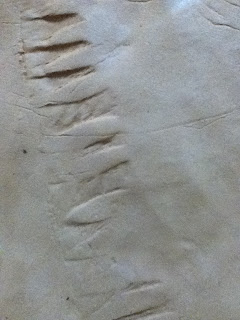This was another unique assignment--for this, we would need a lino block, lino cutters, carbon paper, construction paper, tracing paper, and printmaking ink.
This assignment was something I was looking forward to. As a fan of whittling, this was something I would enjoy. Carving allowed me to kind of be with my thoughts, and this would allow us to express our thoughts, as we would be tracing the outline of an image, and then make it our own by filling in the interior with different things--I thought of it as photoshop since we would use different layers to create a final image.My original outline was that of Ray Lewis, a linebacker for the Baltimore Ravens and my all time favorite football player. But I had quite a time deciding how I would fill him in. I tried different things, most notable of which was a judo design, as Mr. Wonenberg suggested. I liked the idea, but wanted to leave it a bit and think on it some more. There was a point where I was just looking at it, and one of my friends started playing the song "Gangnam Style." Now, as much as I do not like the song, it just stuck in my head and I knew it would pop--especially since the average Korean figure is MUCH smaller than that of Ray Lewis's giant wall of muscle. I added a radial design surrounding the central image to give it that extra pop. Once that was done, I traced the image unto the lino block using the carbon paper. Cutting the block proved quite difficult for me, however, due to my image requiring quite a bit of fine details. I admit, I did press too hard while carving and carved off a little more than I needed on the figure. But the design on the background came out exactly as I wanted it to--it was a radial pattern...without really being in a particular pattern. Now for the inking process. This is where I stumbled--I was unable to get a smooth layer on my block, so many of my images came out spotty. I ended making around 20 different prints, all of them similar, but none quite exactly the same. I noticed a couple times that I would need to carve out a little more to get some finer details to show on the copy, which did work out. Despite the difficulties on this specific project, I did thoroughly enjoy it and may do it when I have some spare time.











